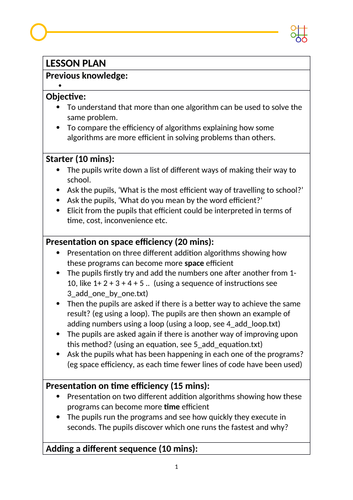













The lesson is suitable for GCSE / KS3 Computer Science (see other similar lessons in this series)
- To understand that more than one algorithm can be used to solve the same problem.
- To compare the efficiency of algorithms explaining how some algorithms are more efficient in solving algorithms than others, specifically space and time efficiency of algorithms
Please leave a comment if you like the resource.
- Lesson plan
- Presentation on space efficiency that looks at a simple algorithm of adding up consecutive numbers (eg 1 + 2 + 3 + 4 … ) in a sequence, then compares this approach with using a loop and then looks at using an equation to solve the problem as an example of space efficiency in an algorithm.
- Pupils program these algorithms for themselves to see how lines of code can be reduced in a program.
- The above presentation is supported by three python programs (eg sequence, loop, equation python programs)
- Presentation on time efficiency that looks at two algorithms (one using a loop and another using an equation) to see which ones are more time efficient.
- Pupils program these algorithms to see how execution time of a program can be reduced.
- The above presentation is supported by two python programs (eg loop and equation python programs)
- The pupils are then given a program task to try to create a program that will calculate the nth term of the sequence 2, 4, 8, 16 in the most efficient way.
- A stretch and challenge exercise considers how to program a more difficult sequence of numbers
- Plenary presentation quiz to test pupils knowledge
- Homework looking at definitions of space and time efficiency and an example algorithm (answers provided)
Something went wrong, please try again later.
Report this resourceto let us know if it violates our terms and conditions.
Our customer service team will review your report and will be in touch.
£0.00
